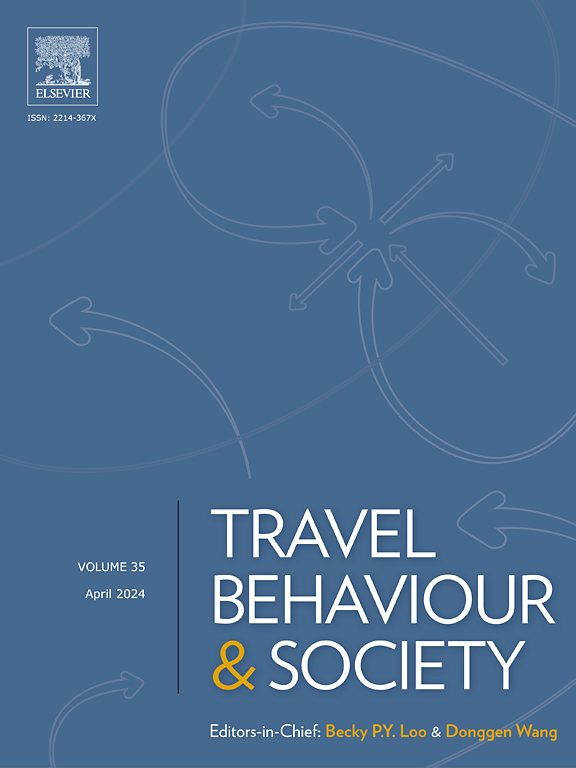What type of person is at different stages of change for cycling? A case study of Montreal
IF 5.1
2区 工程技术
Q1 TRANSPORTATION
引用次数: 0
Abstract
Promoting cycling for daily transport has significant health, equity, and environmental benefits. To understand what factors influence individuals’ cycling motivational stages, our study pursued two main objectives: 1) Enhancing the Stage Model of Self-Regulated Behavioral Change (SSBC) by integrating it with the psychological mechanisms of the TPB, and 2) Examining the impacts of perceived cycling motivators and barriers, cycling and general attitudes, and sociodemographics on cycling motivational stage. Using an online survey of the adult population (n = 1055) in Montreal, Canada, a multivariate analysis reveals meaningful connections between behaviour stages and perceived barriers and attitudes toward cycling. Those in the lowest stage exhibit lower internal motivation and express concerns about the lack of convenience, physical effort, and slowness associated with cycling. Furthermore, the results challenge the common understanding that people always progress through the stages with increasingly positive attitudes and more cycling. Specifically, our findings highlight the need to distinguish between people who cycle by choice and those who do so out of necessity (i.e., captive riders) when categorizing travelers into action and post-action stages. This is important due to the risk of people in the “captive action stage” going back to using cars if barriers are reduced. This suggests that intervention policies should also focus on current cyclists, not just non-cyclists of the preaction stages. This nuanced understanding can inform more effective and targeted interventions for promoting cycling. Finally, objective characteristics of cycling infrastructure retains significance in explaining who belongs to the postaction stage for cycling, even after controlling for residential self-selection.
什么样的人处于不同的骑车变化阶段?以蒙特利尔为例
提倡骑自行车作为日常交通方式具有显著的健康、公平和环境效益。为了了解影响个体骑行动机阶段的因素,本研究的主要目的有两个:1)通过整合自我调节行为改变阶段模型(SSBC)与TPB的心理机制,完善SSBC阶段模型;2)考察感知的骑行动机和障碍、骑行和一般态度以及社会人口统计学对骑行动机阶段的影响。通过对加拿大蒙特利尔成年人(n = 1055)的在线调查,一项多变量分析揭示了行为阶段与感知障碍和对自行车的态度之间有意义的联系。那些处于最低阶段的人表现出较低的内在动力,并对骑车缺乏便利、体力消耗和速度慢表示担忧。此外,研究结果挑战了人们的共识,即人们总是以越来越积极的态度和更多的骑行在各个阶段取得进步。具体来说,我们的研究结果强调,在将旅行者分为行动阶段和行动后阶段时,有必要区分自愿骑车的人和非自愿骑车的人(即“俘虏骑手”)。这一点很重要,因为如果障碍减少,处于“俘虏行动阶段”的人们可能会重新使用汽车。这表明干预政策也应该关注当前的骑自行车者,而不仅仅是预防阶段的非骑自行车者。这种微妙的理解可以为促进骑自行车提供更有效和有针对性的干预措施。最后,即使在控制了居民自我选择之后,自行车基础设施的客观特征对于解释谁属于自行车的后行动阶段仍然具有重要意义。
本文章由计算机程序翻译,如有差异,请以英文原文为准。
求助全文
约1分钟内获得全文
求助全文
来源期刊

Travel Behaviour and Society
TRANSPORTATION-
CiteScore
9.80
自引率
7.70%
发文量
109
期刊介绍:
Travel Behaviour and Society is an interdisciplinary journal publishing high-quality original papers which report leading edge research in theories, methodologies and applications concerning transportation issues and challenges which involve the social and spatial dimensions. In particular, it provides a discussion forum for major research in travel behaviour, transportation infrastructure, transportation and environmental issues, mobility and social sustainability, transportation geographic information systems (TGIS), transportation and quality of life, transportation data collection and analysis, etc.
 求助内容:
求助内容: 应助结果提醒方式:
应助结果提醒方式:


